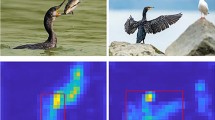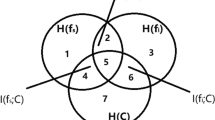Abstract
To match human perception, extracting perceptual features effectively plays an important role in image quality assessment. In contrast to most existing methods that use linear transformations or models to represent images, we employ a complex mathematical expression of high dimensionality to reveal the statistical characteristics of the images. Furthermore, by introducing kernel methods to transform the linear problem into a nonlinear one, a full-reference image quality assessment method is proposed based on high-dimensional nonlinear feature extraction. Experiments on the LIVE, TID2008, and CSIQ databases demonstrate that nonlinear features offer competitive performance for image inherent quality representation and the proposed method achieves a promising performance that is consistent with human subjective evaluation.
Similar content being viewed by others
References
Abdi, H., Williams, L.J., 2010. Principal component analysis. Wiley Interdiscip. Rev. Comput. Stat., 2(4): 433–459. http://dx.doi.org/10.1002/wics.101
Bach, F.R., Jordan, M.I., 2003. Kernel independent component analysis. Proc. IEEE Int. Conf. on Acoustics, Speech, and Signal Processing, p.IV-876-9. http://dx.doi.org/10.1109/ICASSP.2003.1202783
Chang, C.C., Lin, C.J., 2011. LIBSVM: a library for support vector machines. ACM Trans. Intell. Syst. Technol., 2(3):Article 27. http://dx.doi.org/10.1145/1961189.1961199
Chang, H.W., Zhang, Q.W., Wu, Q.G., et al., 2015. Perceptual image quality assessment by independent feature detector. Neurocomputing, 151:1142–1152. http://dx.doi.org/10.1016/j.neucom.2014.04.081
Ding, Y., Dai, H., 2014. Image quality assessment scheme with topographic independent components analysis for sparse feature extraction. Electron. Lett., 50(7): 509–510. http://dx.doi.org/10.1049/el.2013.4298
Genton, M.G., 2001. Classes of kernels for machine learning: a statistics perspective. J. Mach. Learn. Res., 2:299–312.
Hyvärinen, A., Hurri, J., Hoyer, P.O., 2009. Natural Image Statistics: a Probabilistic Approach to Early Computational Vision. Springer-Verlag London, UK.
Jolliffe, I., 2002. Principal Component Analysis. Springer-Verlag New York, USA.
Larson, E.C., Chandler, D.M., 2010. Most apparent distortion: full-reference image quality assessment and the role of strategy. J. Electron. Imag., 19(1):011006. http://dx.doi.org/10.1117/1.3267105
Li, Q., Wang, Z., 2009. Reduced-reference image quality assessment using divisive normalization-based image representation. IEEE J. Sel. Topics Signal Process., 3(2): 202–211. http://dx.doi.org/10.1109/JSTSP.2009.2014497
Li, Y.C., Wu, K.H., Ma, Y.L., et al., 2007. Image digital watermarking technique based on kernel independent component analysis. Proc. 11th Int. Conf. on Rough Sets, Fuzzy Sets, Data Mining and Granular Computing, p.467–474. http://dx.doi.org/10.1007/978-3-540-72530-5_56
Liu, A., Lin, W., Narwaria, M., 2012. Image quality assessment based on gradient similarity. IEEE Trans. Image Process., 21(4): 1500–1512. http://dx.doi.org/10.1109/TIP.2011.2175935
Liu, M., Yang, X., 2009. Image quality assessment using contourlet transform. Opt. Eng., 48(10):107201. http://dx.doi.org/10.1117/1.3241996
Liu, T.J., Lin, W., Kuo, C.C.J., 2013. Image quality assessment using multi-method fusion. IEEE Trans. Image Process., 22(5): 1793–1807. http://dx.doi.org/10.1109/TIP.2012.2236343
Ma, L., Li, S., Ngan, K.N., 2013. Reduced-reference image quality assessment in reorganized DCT domain. Signal Process. Image Commun., 28(8): 884–902. http://dx.doi.org/10.1016/j.image.2012.08.001
Mittal, A., Moorthy, A.K., Bovik, A.C., 2012. No-reference image quality assessment in the spatial domain. IEEE Trans. Image Process., 21(12): 4695–4708. http://dx.doi.org/10.1109/TIP.2012.2214050
Rao, D.V., Reddy, L.P., 2009. Contrast weighted perceptual structural similarity index for image quality assessment. Proc. Annual IEEE India Conf., p.1–4. http://dx.doi.org/10.1109/INDCON.2009.5409432
Rehman, A., Wang, Z., 2012. Reduced-reference image quality assessment by structural similarity estimation. IEEE Trans. Image Process., 21(8): 3378–3389. http://dx.doi.org/10.1109/TIP.2012.2197011
Schölkopf, B., Smola, A.J., 1998. Learning with Kernels. MIT Press.
Sheikh, H.R., Bovik, A.C., de Veciana, G., 2005. An information fidelity criterion for image quality assessment using natural scene statistics. IEEE Trans. Image Process., 14(12): 2117–2128. http://dx.doi.org/10.1109/TIP.2005.859389
Video Quality Experts Group, 2003. Final Report from the Video Quality Experts Group on the Validation of Objective Models of Video Quality Assessment, Phase II(fr_tv2). Available from http://www.vqeg.org.
Wang, Z., Li, Q., 2011. Information content weighting for perceptual image quality assessment. IEEE Trans. Image Process., 20(5): 1185–1198. http://dx.doi.org/10.1109/TIP.2010.2092435
Wang, Z., Bovik, A.C., Lu, L.G., 2002. Why is image quality assessment so difficult? Proc. IEEE Int. Conf. on Acoustics, Speech, and Signal Processing, p.1–4. http://dx.doi.org/10.1109/ICASSP.2002.5745362
Wang, Z., Simoncelli, E.P., Bovik, A.C., 2003. Multiscale structural similarity for image quality assessment. Proc. 37th Asilomar Conf. on Signals, Systems and Computers, p.1398–1402. http://dx.doi.org/10.1109/ACSSC.2003.1292216
Wang, Z., Bovik, A.C., Sheikh, H.R., et al., 2004. Image quality assessment: from error visibility to structural similarity. IEEE Trans. Image Process., 13(4): 600–612. http://dx.doi.org/10.1109/TIP.2003.819861
Wu, Q., Li, H., Meng, F., et al., 2015. No reference image quality assessment metric via multi-domain structural information and piecewise regression. J. Vis. Commun. Image Represent., 32:205–216. http://dx.doi.org/10.1016/j.jvcir.2015.08.009
Wu, Q., Li, H., Meng, F., et al., 2016. Blind image quality assessment based on multichannel feature fusion and label transfer. IEEE Trans. Circ. Syst. Video Technol., 26(3): 425–440. http://dx.doi.org/10.1109/TCSVT.2015.2412773
Yang, C.A., Kaveh, M., 2010. Image quality assessment using singular vectors. Proc. SPIE, Article 752910. http://dx.doi.org/10.1117/12.839796
Yang, J., Gao, X., Zhang, D., et al., 2005. Kernel ICA: an alternative formulation and its application to face recognition. Patt. Recog., 38(10): 1784–1787. http://dx.doi.org/10.1016/j.patcog.2005.01.023
Zhang, H., Ding, Y., Huang, K., et al., 2014. Image quality assessment by quantifying discrepancies of multifractal spectrums. IEICE Trans. Inform. Syst., 97(9): 2453–2460. http://dx.doi.org/10.1587/transinf.2014EDP7036
Zhang, L., Zhang, L., Mou, X., et al., 2011. FSIM: a feature similarity index for image quality assessment. IEEE Trans. Image Process., 20(8): 2378–2386. http://dx.doi.org/10.1109/TIP.2011.2109730
Zhang, M., Muramatsu, C., Zhou, X., et al., 2015. Blind image quality assessment using the joint statistics of generalized local binary pattern. IEEE Signal Process. Lett., 22(2): 207–210. http://dx.doi.org/10.1109/LSP.2014.2326399
Zhang, Y., Chandler, D.M., 2013. No-reference image quality assessment based on log-derivative statistics of natural scenes. J. Electron. Imag., 22(4):043025. http://dx.doi.org/10.1117/1.JEI.22.4.043025
Author information
Authors and Affiliations
Corresponding author
Additional information
Project supported by the National High-Tech R&D Program (863) of China (No. 2015AA016704c), the National Science & Technology Support Program of China (No. 2013BAH03B01), and the Zhejiang Provincial Natural Science Foundation of China (No. LY14F020028)
ORCID: Yong DING, http://orcid.org/0000-0002-5226-7511
Rights and permissions
About this article
Cite this article
Ding, Y., Li, N., Zhao, Y. et al. Image quality assessment method based on nonlinear feature extraction in kernel space. Frontiers Inf Technol Electronic Eng 17, 1008–1017 (2016). https://doi.org/10.1631/FITEE.1500439
Received:
Accepted:
Published:
Issue Date:
DOI: https://doi.org/10.1631/FITEE.1500439
Keywords
- Image quality assessment
- Full-reference method
- Feature extraction
- Kernel space
- Support vector regression




